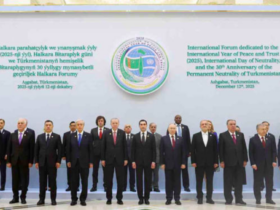The shale gas revolution had provided the US with an opportunity not only to become energy efficient, but also a natural gas exporter. US interests in energy exports hinges on boosting relations with neighbors and allies. Turkey’s growing economy and equally increasing energy demands make it a good candidate for US liquified natural gase (LNG) supplies. At present, Turkey imports most of its natural gas from Russia, Iran and Azerbaijan.
The US’ LNG has the potential to provide an alternative to Iranian natural gas in Turkey’s domestic market. Trump is currently actively trying to decrease Iran’s influence in the region and weaken its economy. Turkey is a major costumer of Iranian natural gas and uses gas from Iran to cover excess winter demand in its South. However, the real question is Turkey’s lack of integrated natural gas infrastructure. Turkey will need more investment to create an integrated infrastructure. Current Iran-Turkey natural gas agreements will end by 2026, and more LNG imports from the US wuld provide an opportunity for Turkey to gain the upper hand in negotiations to decrease natural gas prices for next decade if both countries want to extend this agreement.
Turkey is also dependent on Russian natural gas, importing more that 50% of natural gas from Russia. Russia and Turkey’s joint construction of the Turkish Stream pipeline will lead to further integration once in operation. Turkey will import natural gas from the Turkish Stream and also export gas to Greece via this pipeline. Last June, Turkey also begin to import natural gas from the TANAP project: Azerbaijan will also increase its share in Turkish natural gas market.
In the past few years, Turkey has made significant contributions to the realization of this dream, with significant investments in infrastructure, especially in terms of pipeline development and increased capacity for the maintenance of LNG and has even supported Qatar in its endeavors to do the same. The country’s natural gas storage capacity will double by 2023 to 11 billion cubic meters. If this is achieved, Turkey will preside over one of the largest gas reservoirs in the region.
A few years ago, Turkey began working to build an import terminal with an annual capacity of 5 to 6 billion cubic meters of gas. Cooperation between Turkey and Qatar is increasing due to agreements between Ankara and Doha on certain political crises in the region.
Within the scope of Kuzey Marmara Natural Gas Storage Expansion Project, there are plans to increase total storage capacity to 4,6 bcm and withdrawal capacity to 75 mcm/day. Furthermore, the TuzGölü (Salt Lake) Natural Gas Underground Storage Project in Central Turkey, whose first phase has since been completed, is planned to reach 5.4 bcm working gas capacity and 80 mcm/day withdrawal capacity by 2023.
The first Floating Storage and Regasification Unit (FSRU) of Turkey has been launched by the national private sector in Aliağa/İzmir to achieve supply security and diversification of gas sources. In Hatay/Dortyol, the second FSRU of Turkey has been opened. Moreover, studies on the connection of FSRU to the natural gas transmission system in Saros Gulfs are continuing by BOTAS. As Berat Albayrak, Turkey’s former Energy Minister stated: “In addition, this time we pressed the button for BOTAS ‘second floating LNG project with a daily capacity of 20 million cubic meters. With the new investments, the LNG capacity to be supplied to the system will rise to 107 million cubic meters per day. This means an increase of more than 3 times (in LNG capacity) after two years of investment. With just the steps we took in 2016, we increased the LNG capacity by 90 percent to 34 million cubic meters to 64 million cubic meters. ”
Turkey’s former Minister of Energy and Natural Resources claims that 78 cities have already been connected to natural gas supplies. Albayrak emphasized that installed power in the next 10 years should increase by 50 thousand megawatts: by 2018 Turkey will have constructed 17 natural gas and LNG facilities and 21 new natural gas reserve facilities. The US plans to play a more active role in Asia over the medium term by investing in related projects in 2018 and 2024.
The United States currently has an active terminal for liquid gas exports. There are also 6 terminals under construction and 30 terminal construction projects for liquid gas exports. At the same time, the capacity of these six terminals under construction in the United States is projected at 57.55 million tons.
The US can use its LNG to undercut Russian LNG and increase its share in the regional and global market. Turkey’s market is one that US LNG can contribute to and help Turley’s energy security at the sime time by reducing dependency on Russia and Iranian natural gas. LNG from the US needs to be more competitive in regional markets in general, and especially in Turkey. Turkey must attract more foreign financial resources and foreign technology and use domestic firm’s technology to invest in the required infrastructure. Similarly, such a development would provide an opportunity for Turkey to move forward in its aim to become a regional natural gas market, benefiting from its increased investment and technological capacities.

















Leave a Reply